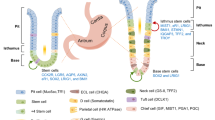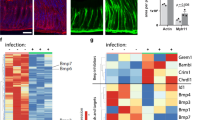Abstract
Sonic Hedgehog (Shh) signaling has been extensively studied for its role in developmental biology and cancer biology. The association between Shh and cancer development in general is well established but the functional role of Shh in the development and progression of gastric cancer specifically is largely unknown. Bone marrow-derived stem cells, specifically mesenchymal stem cells (MSCs) infiltrate and engraft into the gastric mucosa in response to the chronic inflammatory environment of Helicobacter infection. In this review, MSC infiltration and changes in the cytokine and cellular profiles of later-stage chronic environments will be tied into their interactions with the Shh pathway. We will discuss how these changes shape tumorigenesis and tumor progression in the gastric mucosa. The current review focuses on the Shh signaling pathway and its role in the development of gastric cancer, specifically in response to Helicobacter pylori infection. We follow with an in-depth discussion of the regulation of the Hedgehog pathway during acute and chronic gastric inflammation with a focus on signaling within the MSC compartment.




Similar content being viewed by others
Abbreviations
- Shh:
-
Sonic Hedgehog
- Ihh:
-
Indian Hedgehog
- Dhh:
-
Desert Hedgehog
- Smo:
-
Smoothened
- Ptch:
-
Patched
- Gli1:
-
Glioma-associated Oncogene homolog 1
- Hh:
-
Hedgehog
- H. pylori :
-
Helicobacter pylori
- Hp:
-
H. pylori
- BMDC:
-
Bone-marrow-derived cells
- MSCs:
-
Bone-marrow-derived mesenchymal stem cells
- CDX2:
-
Caudal-type homeobox transcription factor 2
- SDF-1:
-
Stromal-derived factor-1
- MDSC:
-
Myeloid-derived suppressor cells
References
Nüsslein-Volhard C, Wieschaus E. Mutations affecting segment number and polarity in drosophila. Nature. 1980;287:795–801.
Ramalho-Santos M, Melton DA, McMahon AP. Hedgehog signals regulate multiple aspects of gastrointestinal development. Development. 2000;127:2763–2772.
Shiotani A, Iishi H, Uedo N, et al. Evidence that loss of sonic hedgehog is an indicator of Helicobater pylori-induced atrophic gastritis progressing to gastric cancer. Am J Gastroenterol. 2005;100:581–587.
van den Brink GR, Hardwick JC, Nielsen C, et al. Sonic hedgehog expression correlates with fundic gland differentiation in the adult gastrointestinal tract. Gut. 2002;51:628–633.
Xiao C, Ogle SA, Schumacher MA, et al. Loss of parietal cell expression of sonic hedgehog induces hypergastrinemia and hyperproliferation of surface mucous cells. Gastroenterology. 2010;138:550–561.
Ma X, Chen K, Huang S, et al. Frequent activation of the hedgehog pathway in advanced gastric adenocarcinomas. Carcinogenesis. 2005;26:1698–1705.
Berman DM, Karhadkar SS, Maitra A, et al. Widespread requirement for hedgehog ligand stimulation in growth of digestive tract tumours. Nature. 2003;425:846–851.
Porter JA, von Kessler DP, Ekker SC, et al. The product of hedgehog autoproteolytic cleavage active in local and long-range signalling. Nature. 1995;374:363–366.
Goetz JA, Singh S, Suber LM, Kull FJ, Robbins DJ. A highly conserved amino-terminal region of sonic hedgehog is required for the formation of its freely diffusible multimeric form. J Biol Chem. 2006;281:4087–4093.
Torroja C, Gorfinkiel N, Guerrero I. Mechanisms of hedgehog gradient formation and interpretation. J Neurobiol. 2005;64:334–356.
Mann RK, Beachy P. Novel lipid modifications of secreted protein signals. Ann Rev Biochem. 2004;73:891–923.
Pepinsky RB, Zeng C, Wen D, et al. Identification of a palmitic acid-modified form of human sonic hedgehog. J Biol Chem. 1998;273:14037–14045.
Goodrich LV, Johnson RL, Milenkovic L, McMahon JA, Scott MP. Conservation of the hedgehog/patched signaling pathway from flies to mice: induction of a mouse patched gene by hedgehog. Genes Dev. 1996;10:301–312.
Taipale J, Cooper MK, Maiti T, Beachy PA. Patched acts catalytically to suppress the activity of smoothened. Nature. 2002;418:892–896.
Hui CC, Slusarski D, Platt KA, Holmgren R, Joyner AL. Expression of three mouse homologs of the drosophila segment polarity gene cubitus interruptus, gli, gli-2, and gli-3, in ectoderm- and mesoderm-derived tissues suggests multiple roles during postimplantation development. Dev Biol. 1994;162:402–413.
DW LiX, Lobo-Ruppert SM, Ruppert JM. Gli1 acts through snail and E-cadherin to promote nuclear signaling by beta-catenin. Oncogene. 2007;26:4489–4498.
Li X, Deng W, Nail CD, et al. Snail induction is an early response to gli1 that determines the efficiency of epithelial transformation. Oncogene. 2006;25:609–621.
Stepan V, Ramamoorthy S, Nitsche H, Zavros Y, Merchant JL, Todisco A. Regulation and function of the sonic hedgehog signal transduction pathway in isolated gastric parietal cells. J Biol Chem. 2005;280:15700–15708.
Zavros Y, Waghray M, Tessier A, et al. Reduced pepsin a processing of sonic hedgehog in parietal cells precedes gastric atrophy and transformation. J Biol Chem. 2007;282:33265–33274.
Waghray M, Zavros Y, Saqui-Salces M, et al. Interleukin-1beta promotes gastric atrophy through suppression of sonic hedgehog. Gastrotenterology. 2010;138:562–572.
Zavros Y, Orr M, Xiao C, Malinowska DH. Sonic hedgehog is associated with h + , k + -ATPase-containing membranes in gastric parietal cells and secreted with histamine stimulation. Am J Physiol. 2008;295:G99–G111.
Vincent S, Thomas A, Brasher B, Benson JD. Targeting of proteins to membranes through hedgehog auto-processing. Nat Biotechnol. 2003;21:936–940.
Yoshida H, Okamoto K, Iwamoto T, et al. Pepstatin A, an aspartic proteinase inhibitor, suppresses rankl-induced osteoclast differentiation. J Biochem. 2006;139:583–590.
Osawa H, Ohnishi H, Takano K, et al. Sonic hedgehog stimulates the proliferation of rat gastric mucosal cells through erk activation by elevating intracellular calcium concentration. Biochem Biophys Res Commun. 2006;344:680–687.
Yoshimine Y, Tsukuba T, Isobe R, et al. Specific immunocytochemical localization of cathepsin E at the ruffled border membrane of active osteoclasts. Cell Tissue Res. 1995;281:85–91.
Houghton J, Stoicov C, Nomura S, et al. Gastric cancer originating from bone marrow-derived cells. Science. 2004;306:1568–1571.
Kim JH, Huang Z, Mo R. Gli3 null mice display glandular overgrowth of the developing stomach. Dev Dyn. 2005;234:984–991.
Suzuki H, Minegishi Y, Nomoto Y, et al. Down-regulation of a morphogen (Sonic hedgehog) gradient in the gastric epithelium of Helicobacter pylori-infected Mongolian gerbils. J Pathol. 2005;206:186–197.
El-Zaatari M, Grabowska A, McKenzie AJ, Powe DG, Scotting PJ, Watson SA. Cyclopamine inhibition of the sonic hedgehog pathway in the stomach requires concomitant acid inhibition. Regul Pept. 2008;146:131–139.
El-Zaatari M, Tobias A, Grabowska AM, et al. De-regulation of the sonic hedgehog pathway in the insgas mouse model of gastric carcinogenesis. Br J Cancer. 2007;96:1855–1861.
Uemura N, Okamoto S, Yamamoto S, et al. Helicobacter pylori infection and the development of gastric cancer. N Engl J Med. 2001;345:784–789.
Correa P, Haenszel W, Cuello C, Tannenbaum S, Archer M. A model for gastric cancer epidemiology. Lancet. 1975;2:58–60.
Correa P, Houghton J. Carcinogenesis of Helicobacter pylori. Gastroenterology. 2007;133:659–672.
Goldenring JR, Nomura S. Differentiation of the gastric mucosa III. Animal models of oxyntic atrophy and metaplasia. Am J Gastroenterol. 2006;291:G999–G1004.
Katoh Y, Katoh M. Hedgehog signaling pathway and gastrointestinal stem cell signaling network (review). Int J Mol Med. 2006;18:1019–1023.
Dimmler A, Brabletz T, Hlubek F, et al. Transcription of sonic hedgehog, a potential factor for gastric morphogenesis and gastric mucosa maintenance, is up-regulated in acidic conditions. Lab Invest. 2003;83:1829–1837.
Minegishi Y, Suzuki H, Arakawa M, et al. Reduced shh expression in tff2-overexpressing lesions of the gastric fundus under hypochlorhydric conditions. J Pathol. 2007;213:161–169.
Zavros Y, Rathinavelu S, Kao JY, et al. Treatment of Helicobacter gastritis with il-4 requires somatostatin. Proc Natl Acad Sci U S A. 2003;100:12944–12949.
El-Omar EM, Carrington M, Chow WH, et al. Interleukin-1 polymorphisms associated with increased risk of gastric cancer. Nature. 2000;404:398–402.
El-Omar EM. The importance of interleukin 1beta in Helicobacter pylori-associated disease. Gut. 2001;48:743–747.
Franic TV, Judd L, Robinson D, et al. Regulation of gastric epithelial cell development revealed in h(+)/k(+)-ATPase beta-subunit- and gastrin-deficient mice. Am J Physiol. 2001;281:G1502–G1511.
Ohta M, Tateishi K, Kanai F, et al. P53-independent negative regulation of p21/cyclin-dependent kinase-interacting protein 1 by the sonic hedgehog-glioma-associated oncogene 1 pathway in gastric carcinoma cells. Cancer Res. 2005;65:10822–10829.
Aihara M, Tsuchimoto D, Takizawa H, et al. Mechanisms involved in Helicobacter pylori-induced interleukin-8 production by a gastric cancer cell line, mkn45. Infect Immun. 1997;65:3218–3224.
Chu SH, Kim H, Seo JY, Lim JW, Mukaida N, Kim KH. Role of NF-kappab and ap-1 on Helicobater pylori-induced il-8 expression in ags cells. Dig Dis Sci. 2003;48:257–265.
Kasperczyk H, Baumann B, Debatin KM, Fulda S. Characterization of sonic hedgehog as a novel NF-kappab target gene that promotes NF-kappab-mediated apoptosis resistance and tumor growth in vivo. FASEB J. 2009;23:21–33.
Watkins DN, Peacock C. Hedgehog signaling in foregut malignancy. Biochem Pharmacol. 2004;68:1055–1060.
Watkins DN, Berman DM, Burkholder SG, Wang B, Beachy PA, Baylin SB. Hedgehog signalling within airway epithelial progenitors and in small-cell lung cancer. Nature. 2003;422:313–317.
Karhadkar SS, Bova G, Abdallah N, et al. Hedgehog signalling in prostate regeneration, neoplasia and metastasis. Nature. 2004;431:707–712.
Kitaori T, Ito H, Schwarz EM, et al. Stromal cell-derived factor 1/cxcr4 signaling is critical for the recruitment of mesenchymal stem cells to the fracture site during skeletal repair in a mouse model. Arthritis Rheum. 2009;60:813–823.
Kyriakou C, Rabin N, Pizzey A, Nathwani A, Yong K. Factors that influence short-term homing of human bone marrow-derived mesenchymal stem cells in a xenogeneic animal model. Haematologica. 2008;93:1457–1465.
Haider HKh, Jiang S, Idris NM, Ashraf M. Igf-1-overexpressing mesenchymal stem cells accelerate bone marrow stem cell mobilization via paracrine activation of sdf-1alpha/cxcr4 signaling to promote myocardial repair. Circ Res. 2008;103:1300–1308.
Tu S, Bhagat G, Cui G, et al. Overexpression of interleukin-1beta induces gastric inflammation and cancer and mobilizes myeloid-derived suppressor cells in mice. Cancer Cell. 2008;14:408–419.
Yagi N, Manabe I, Tottori T, et al. A nanoparticle system specifically designed to deliver short interfering RNA inhibits tumor growth in vivo. Cancer Res. 2009;69:6531–6538.
Schugar RC, Robbins P, Deasy BM. Small molecules in stem cell self-renewal and differentiation. Gene Ther. 2008;15:126–135.
Acknowledgments
We sincerely thank Glenn Doerman (Graphic Design, Illustrations, Presentations & Desktop Publishing, Departments of Cancer & Cell Biology and Molecular and Cellular Physiology, University of Cincinnati) for helping us generate Figs. 1, 2, 3, and 4. This work was supported by start-up funds (Department of Molecular and Cellular Physiology, University of Cincinnati) and from the Digestive Health Center Cincinnati Children’s Medical Health Center (DHC: Bench to Bedside Research in Pediatric Digestive Disease) Pilot and Feasibility Project Award CHTF/SUB DK078392 (Y.Z.).
Author information
Authors and Affiliations
Corresponding author
Rights and permissions
About this article
Cite this article
Martin, J., Donnelly, J.M., Houghton, J. et al. The Role of Sonic Hedgehog Reemergence During Gastric Cancer. Dig Dis Sci 55, 1516–1524 (2010). https://doi.org/10.1007/s10620-010-1252-z
Received:
Accepted:
Published:
Issue Date:
DOI: https://doi.org/10.1007/s10620-010-1252-z




